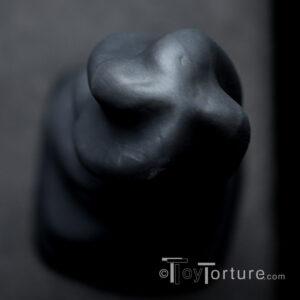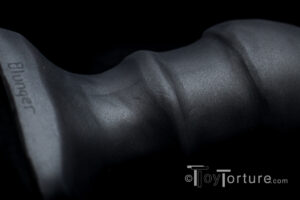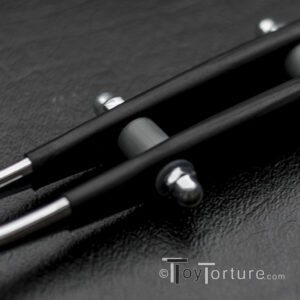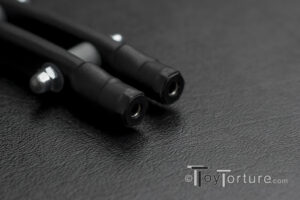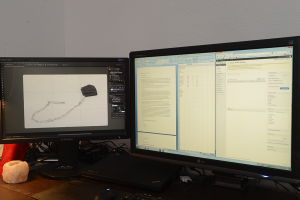| Toy Properties
Form: Dildo |
Vendor: Mr Hankey’s
After the Anal Toy Special this spring, I have gotten over a hundred messages from you, complaining that I never talk about realistic dildos. Since I always try to satisfy your thirst, I reached out to one of the best realistic dildo makers on the planet to give you this threesome review.
Construction
Like all toys in this anal toy special, Mr Hankey manufactures its toy out of platinum silicone. Platinum silicone is a premium, more expensive material than other kinds of silicone which for example use tin as a catalyst to cure the silicone. This means all Mr Hankey toys are 100% body safe, highly resistant towards acid and heat and with the super-smooth surface leave little possibilities for bacteria to linger and are easy to clean. I usually put my toys in hot water with dish soap and sanitize them afterwards for good measure. This is a quick and easy way to get the toys clean and sterile again between partners at a play party. But you can also throw them in the dishwasher or autoclave them. In order to keep the surface in this condition, never use silicone based or hybrid lube with silicone toys because they will disintegrate the surface. Water and oil based lube are safe to be used with silicone toys.
Silicone is a material that can be colored easily and which color does not fade over time. As standard colors Mr Hankey’s only offers their dildos in black, natural tan or deep brown. However, for $29.95 you can get custom coloring, mostly duo-tone fades like I got on my Nick Capra and Lampwick but other designs are possible. It is a bit of an investment but since these toys are cheap, I recommend customizing them for this small fee because they turn out gorgeous and make your toy a bit of your own! If you need inspiration, browse Mr Hankey’s Twitter feed.
Firmness-wise you also get only two choice. First there is Medium which is a bit firmer, about the firmness of a rock-hard dick. If you are a texture junkie like me, you definitely want to go this way because it makes every ridge and vein very noticeable! 75% firmness is a bit softer. It turns the texture into tantalizing massage spots and thus is more recommended for the novice. A word of advice though: Especially on longer and thinner toys, 75% firmness can be a bit too soft so the toy can collapse when riding it. Mr Hankey’s Toys does offer custom firmness if you want the toys smoother or firmer. I have not tried that service but I would only recommend it for their fantasy toys. In my testee panel none wished for firmer or softer option than the two available on realistic dildos. For only $4.95 a Vac-U-Loc hole can be added to every toy. Originally designed to attach the toy to fuck machines, there are a number of nifty accessories out there for this kind of system: Handles, Strap-On harnesses, suction cups and double-dildo connectors. Because of this I highly recommend adding this inexpensive feature to your toy. There are just too many useful scenarios along the way to go cheap on this one.

Detail of the Nick Capra’s Base with a Vac-U-Lock Hole and the Link to his OnlyFans’s Page. Future Generations will Wonder what this will have meant…
As already said in the introduction, all three toys in this review are realistic toys. The closest to this definition comes the Nick Capra which was cast off the life dick of the porn star. It starts out with a very prominent yet nicely tapered glans which has a very prominent rim with a steep drop below. The shaft is very unevenly textured: Almost no veins on top and some very subtle ones on the back. After the glans drop the shaft tappers gradually towards the balls.
The Lampwick starts out very similar with a nicely shaped glans for easy entry and a very distinct drop below the rim. This is where the similarities start: The shaft is heavily textured with veins and a thick ventral groove but in exchange does not noticeable increase in diameter. In relation to the diameter, the Lampwick is a very long toy, almost prone towards depth play in 75% Firmness (as a texture junkie I of course chose Medium firmness ;)). The balls merge into a solid and thick base.
The final member of this ménage à trios is called El Ray and it is the only uncut guy of this bunch. Finally an uncut realistic dildo! Being uncut myself and favoring uncut dicks with my play partners, I love seeing this feature on a dildo. Naturally this makes the tip of the dick a bit more challenging. The rock hard, straight up shaft has caused the foreskin to retract a bit, exposing about a third of the glans which could make for an easy insertion – if there wasn’t the small, steep rim of the foreskin as a first bump. Once you have taken that, there is the glans rim. Being covered by foreskin, the drop is smoother than on the other two but the bump is thicker. Below the glans the shaft diameter increases gradually to reach is maximum diameter at about a third of the shaft and then tappers softly towards the round base.
| Toy | Size | Diameter Glans Rim | Diameter Shaft Middle | Diameter Above Balls | Insertable Length |
| Nick Capra | Original | 48mm | 58mm | 58mm | 170mm |
| Medium | 57mm | 70mm | 71mm | 203mm | |
| LG/ XL | 71mm | 87mm | 89mm | 254mm | |
| XXL | 82mm | 101mm | 102mm | 292mm | |
| Lampwick | S | 40mm | 45mm | 47mm | 178mm |
| M | 59mm | 63mm | 65mm | 254mm | |
| LG/ XL | 69mm | 73mm | 75mm | 296mm | |
| XXXL | 75mm | 83mm | 85mm | 325mm | |
| El Ray | M | 59mm | 71mm | 65mm | 279mm |
| L | 64mm | 77m | 71mm | 311mm | |
| XL | 71mm | 85mm | 79mm | 330mm | |
| XXL | 77mm | 91mm | 85mm | 356mm |
Playing with the Nick Capra, Lampwick & El Ray
Let’s start out with the Nick Capra, because ever since I posted the first pic of this toy on my Twitter feed, I have gotten the most questions about this dildo. Maybe because of his large fan base… As already written above the glans is easy to take with a sudden drop. Especially in medium firmness and for the novice this might come as a surprise and will make taking out the toy after you have come a bit of a challenge. For the more seasons anal player, the ridge on top of the glans rim is perfect for massaging the sphincter and with a bit of practice to stimulate the prostate.
The glans’ cliff should not discourage the novices among you because the shaft is actually ideal for girth training. The increase in diameter is so gradual and smooth that in combination with the subtle texturing and the lack of a noticeable ventral groove the stretch is almost the only sensation felt when riding the Nick Capra. The low-hanging balls are also realistically sculptured. Though they are a bit soft and through the thin neck give in easily, they are good to hold onto for solo play if you chose not to get the Vac-U-Lock hole with a handle.
While the Nick Capra is a good toy for stretch beginners, especially the ones who want to get into sphincter and prostate play, the Lampwick is made for loose holes. Even if the diameter fits on paper with a plug, the thick veins make taking this toys a bit of a struggle which the stimulation of the sphincter can have ecstatic effects. Slowly ride the toy to massage the sphincter and in the right angle the prostate, twist it for the deep ventral groove to target the prostate or piston fuck the bottom’s hole to torment and tire it out. I had the opportunity to play with a friend’s 75% firmness LG/XL and directly compare it to mine. And yes, the heavy texture is felt less intensely. But if you can just barely fit the maximum diameter, it still will be an uncomfortable ride. But if you are into extreme stimulation of the many nerve endings inside the anus like I am, take a look at the Lampwick in Medium!
One of my testees is really experienced in depth play (and he has a favorable anatomy). He was able to take the Lampwick completely with a lot of lube and a lot of poppers. He said that the pop of the glans through his second sphincter was probably one of the most intense experiences he ever had and twisting the rugged shaft inside his two sphincters lead to noises I have never heard from him. As demonstrate, it is possible to take a Medium firmness Lampwick deep, I advise even more caution than with usual depth play and would actually say, if you want to take this dildo deep, go for the 75% firmness option.
Due to the thick and wide base into which the balls flow, the Lampwick has a very good sturdiness. Even when riding it vigorously on your own, none of my testess had problems with the base slipping away. The base is also big and grippy enough, to allow for a top to hold and control the dildo comfortably when fucking a bottom with it. It only falls short when you want to fuck yourself with it. It is a bit cumbersome for that; I recommend a Vac-U-Lock handle in that szenario.
Last but definitely not least of this happy bunch is the El Ray. This toy was reason to much discussion in my testee panel. We all like the El Ray. The shape with the maximum diameter fairly far up at the shaft makes for an interesting experience: Once conquered, the toys is getting sucked into the ass. Usually when taking a toy out, it is getting easier the further out it goes. But with the El Ray, the diameter increases again, before you can rest. This is a very interesting and mind fucking experience. The diameter increase is so gradual and smooth that in combination with the almost untextured surface it just feels not like a normal dildo. You cannot pinpoint it, it is just reverse and that makes it hot – especially when you are into the stretch sensations.
This very subtle increase in diameter at the top half of a dildo makes it also a good training toy for girth training. It gently massages the hole loose and open over time without have to go too deep. BUT: The glans with the foreskin half pulled over makes the initial taking of the dildo challenging for novices. Ever the experienced holes in my testee panel needed some prestretching and loosening up before the El Ray could easily enter. After this point, the gentle ridges the foreskin created nicely massage the anus. But getting there takes some prep work. So since even the smaller sizes of the El Ray are already on the larger end of the experience spectrum, it is a toy for the more experienced anal pig.
Where to buy?
Mr Hankey sells their toys directly through their website. This is the best way to get them when you want to customize them even further. They also run promotions on a regular basis so check their page regular to snatch a bargain. Depending on the size and features, the Nick Capra costs between $129.95 and $233.90, the Lampwick between $129.95 and $229.90 and finally the El Ray between $139.95 and $194.90. Custom colors costs $29.95, custom firmness $15.95.











